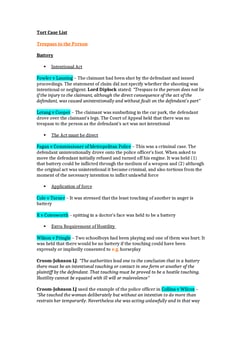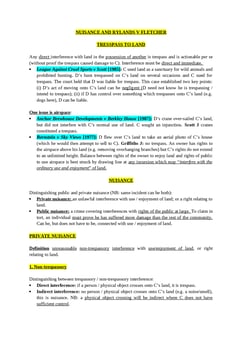Alcock v Chief Constable of South Yorkshire [1992] 1 AC 310
Judgement for the case Alcock v Chief Constable of South Yorkshire
KEY POINTS
-
In negligence-related disasters, the foreseeability of consequential injuries, particularly nervous shock to victims' relatives, is a central legal concern.
Whether these relatives were present at the scene or witnessed the event through live broadcasts, the key question is whether their emotional distress was reasonably foreseeable.
Courts assess the proximity of the relationship between the victims' relatives and the negligent party to determine liability.
In complex legal scenarios, legal outcomes hinge on the interplay between foreseeability, causation, and the closeness of the relationship.
FACTS
-
Peter Wright ("Defendant"), responsible for policing a football match, faced legal action after 95 individuals died and many were injured due to overcrowding in the stadium.
The disaster was televised live, affecting Stephen Jones, Joseph Kehoe, Harold Copoc, Brenda Hennessey, Brian Harrison, B William Pemberton, Alexandra Penk, Robert Spearrit, John O'Dell, Karen Hankin, Catherine Jones, Agnes Copoc, Denise Hough, Robert Alcock, Maureen Mullaney and Peter Coldicutt ("Plaintiffs") who were either present at the stadium or watched it unfold on live television.
Nine Plaintiffs, close relatives who witnessed the tragedy firsthand or on live TV, were allowed to claim damages for nervous shock.
However, six other Plaintiffs were excluded due to a more remote relationship or learning about the disaster through means other than live television broadcasts.
The Court of Appeal upheld the Defendant's appeal, dismissing the unsuccessful Plaintiffs' cross-appeal.
JUDGEMENT
-
On appeal by the Plaintiffs, it was held that establishing a claim for psychiatric illness resulting from shock required not only demonstrating the foreseeability of such injury but also proving a sufficiently proximate relationship between the plaintiff and the Defendant.
The scope of persons owed a duty of care was not confined to specific relationships but extended to ties of love and affection, with closeness requiring individual proof.
Remoter relationships underwent careful scrutiny, and Plaintiff had to demonstrate propinquity in time and space to the accident or its immediate aftermath.
-
The appeal was dismissed.
For the Plaintiffs present at the football match, the mere existence of the relationship was deemed insufficient to establish a duty of care.
Watching the disaster on television was not equivalent to being within sight and hearing of the event or its immediate aftermath.
The Plaintiffs' claims failed. The decision of the Court of Appeal was affirmed.
COMMENTARY
The case highlights the important consideration of the foreseeability of emotional distress, particularly nervous shock to victims' relatives, and the assessment of the relationship's proximity to determine liability.
While nine plaintiffs with close ties and direct exposure to the disaster were allowed to claim damages, six others were excluded due to a more remote relationship or learning about the incident through means other than live TV.
-
The appeal by the plaintiffs, aiming to establish a duty of care, was dismissed.
The court affirmed that the mere existence of a relationship wasn't sufficient, and watching the disaster on television didn't equate to being within sight and hearing of the event.
In conclusion, the Plaintiffs' claims failed, underscoring the complexity of legal outcomes in negligence cases.
ORIGINAL ANALYSIS
R was in charge of policing at the Hillsborough disaster, where there was a crush and people died.
Judge and CA had ruled that only people who had a relationship with those that had died AND had seen the incident first hand (NOT television) could claim for nervous shock, i.e. psychiatric illness.
HL upheld the ruling.
HL
-
To claim nervous shock one has to show:
Reasonable foreseeability,
Propinquity in time and space to the accident,
Proximity between Plaintiff and Defendant, established by the close ties to the victim - not limited to types of relationships, e.g. relative, but by “love and affection”, which has to be proven in each case.
In this case, hearing of the disaster on radio or via TV reports subsequently didn’t satisfy condition 2 (though watching on live television did).
HL refused to extend the meaning of immediate aftermath to identification of a body in the morgue 9 hours after the event, though the plaintiffs that rushed to the hospital straight away were within the “immediate aftermath”.
Lord Keith
Closeness doesn’t just occur in certain types of relationship. Propinquity of time and space includes “immediate aftermath”.
Lord Ackner
-
He says that he would not rule out allowing a claim by a simply bystander who suffered psychiatric shock where any reasonable person would have suffered the same:
He says it is fair to compensate a person who witnesses an oil tanker crashing into a school and killing children (Lords Keith and Oliver support this and say reasonable foreseeability of nervous shock might occur in the case of a horrific accident) - possibly floodgates worries.
Although he says that there are no fixed categories about what type of relationships allow for nervous shock claims, the further removed a person is (e.g. not related, married, etc.) the stronger the evidence will have to be that they had a close enough relationship with Victim, in contrast to married couples who have a de facto prima facie presumption that they are sufficiently close.
Simultaneous broadcasts CANNOT BE RULED OUT completely provided they are the equivalent of seeing the event for oneself with enough clarity, etc., e.g. if a mother on TV saw her two children dropping out of a hot air balloon and falling to their death then that would suffice.
Lord Oliver
NB see Oliver’s guidelines on primary victimhood for psychiatric harm below (Hunter v BCC).
He draws a distinction between “participants” (primary victims) and “witnesses” (secondary victims) in crime, participants being subject to a risk of physical injury themselves.
If Defendant’s negligence foreseeably made Plaintiff an unwilling participant in the event there is proximity between Defendant and Plaintiff “and the principal question is whether, in the circumstances, injury of that type to that plaintiff was or was not reasonably foreseeable,” i.e. if so, then he is a primary victim
RELATED CASES
For Further Study on Alcock v Chief Constable of South Yorkshire
Need instant answers? Our AI exam tutor is here to help.
Ask questions 🙋 Get answers 📔 It's simple 👁️👄👁️
Our AI is educated by the highest scoring students across all subjects and schools. Join hundreds of your peers today.
Get StartedSimilar Cases
Related Product Samples
These product samples contain the same concepts we cover in this case.
| GDL Tort Law | Negligence Psychiatric Harm Notes (5 pages) |
| GDL Tort Law | Psychiatric Injury Notes (8 pages) |


 Since 2010, Oxbridge Notes has been a trusted education marketplace, supplying high-quality materials from top achievers at universities like Oxford, Cambridge, LSE, Harvard, and Yale.
Since 2010, Oxbridge Notes has been a trusted education marketplace, supplying high-quality materials from top achievers at universities like Oxford, Cambridge, LSE, Harvard, and Yale.